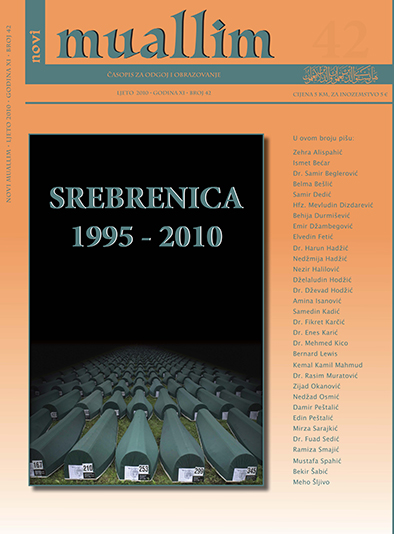ODNOS PREMA PROŠLOSTI U BOŠNJAČKOM RAZUMIJEVANJU ISLAMA U XX STOLJEĆU
DOI:
https://doi.org/10.26340/muallim.v11i42.769Sažetak
U uvodnom dijelu teksta autor razmatra i obrazlaže važnost i značenje prostora i vremena kao dva nerazdvojna okvira unutar kojih nastaju, razvijaju se i nestaju svi događaji u povijesti. Sve religije i kulture upućuju na poznavanje i pamćenje povijesti. Autor ističe tri osnovne dimenzije islamskog poimanja povijesti. Prvu dimenziju povijesti predstavljaju Božija kazivanja i svjedočenja o poslanicima. Zadatak i cilj druge dimenzije povijesti jeste da kazuje istinite i stvarne događaje. I najzad, trećom dimenzijom povijesti, takozvanim Tarihom, utvrđuje se precizan slijed i redoslijed povijesnih događaja. Po mišljenju autora teksta, bit povijesti u islamu je čovjekovo ispunjenje misije na zemlji kao Božijeg Namjesnika i Povjeritelja na zemlji. Autor se kritički osvrće i na sadržaj objavljivanih radova u bošnjačkoj publicistici 20. stoljeća kojim dominiraju prijevodi, deskripcija, sinkretizam, panegirici i kompilacije. Najznačajnijim uspjehom Islamske zajednice u 20. stoljeću autor smatra otvaranje Islamskog teološkog fakulteta u Sarajevu 1977. godine, a u političkom i državnom životu to je međunarodno priznanje i odbrana Države Bosne i Hercegovine i odbrana Bošnjaka od nestanka u razdoblju od 1990. do 1996. godine.
Downloads
Objavljeno
How to Cite
Broj časopisa
Rubrika
License
Naknada:
a. Časopis ne naplaćuje naknadu za obradu članaka (APC) i naknadu za podnošenje članaka.
Autori koji objavljuju u ovom časopisu pristaju na sljedeće uvijete:
- Autori zadržavaju autorska prava i pružaju časopisu pravo prvog objavljivanja, pri čemu će rad jednu godinu po objavljivanju biti podložan licenci Creative Commons imenovanje koja omogućuje drugima da dijele rad uz uvijet navođenja autorstva i izvornog objavljivanja u ovom časopisu.
- Autori mogu izraditi zasebne, ugovorne aranžmane za ne-ekskluzivnu distribuciju rada objavljenog u časopisu (npr. postavljanje u institucionalni repozitorij ili objavljivanje u knjizi), uz navođenje da je rad izvorno objavljen u ovom časopisu.


